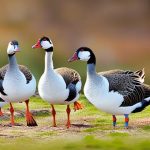Geese infestation is a common problem in many areas, causing damage to crops, parks, and golf courses, as well as creating unsightly and unsanitary conditions. Finding an effective solution to control geese populations is essential for maintaining the aesthetics and functionality of these spaces. One solution that has gained popularity in recent years is the use of decoys. Decoys are lifelike replicas of geese that are strategically placed to deter real geese from settling in an area. In this article, we will explore the different types of decoys available, the science behind their effectiveness, how to place them for maximum effectiveness, and the benefits of using decoys for geese control.
Key Takeaways
- Geese control with decoys is an effective and humane solution to deter geese from unwanted areas.
- There are different types of decoys available, including silhouette, motion, and sound decoys.
- The science behind geese deterrence with decoys involves mimicking natural geese behavior and creating a sense of danger.
- Proper placement of decoys is crucial for maximum effectiveness, including considering wind direction and spacing.
- Benefits of using decoys for geese control include cost-effectiveness, eco-friendliness, and long-term effectiveness.
Types of Decoys Used to Deter Geese
There are several types of decoys available for deterring geese. The most common types include silhouette decoys, full-body decoys, and motion decoys. Silhouette decoys are flat cutouts that resemble the shape of a goose when viewed from a distance. They are lightweight and easy to transport and set up. Full-body decoys, as the name suggests, are three-dimensional replicas of geese that are placed on stakes or stands. They provide a more realistic appearance and can be more effective in deterring geese. Motion decoys are designed to mimic the movement of real geese, either through flapping wings or floating on water. They add an extra level of realism to the decoy setup.
Each type of decoy has its pros and cons. Silhouette decoys are cost-effective and easy to set up, but they may not be as effective as full-body or motion decoys in deterring geese. Full-body decoys provide a more realistic appearance but can be more expensive and require more effort to set up and maintain. Motion decoys can be highly effective in deterring geese, but they can also be more expensive and require batteries or other power sources to operate. It is important to consider the specific needs and budget of your situation when choosing the type of decoy to use.
The Science Behind Geese Deterrence with Decoys
The effectiveness of decoys in deterring geese lies in the principle of visual deterrence. Geese are social animals that rely on visual cues to determine the safety of an area. When they see a group of geese, they interpret it as a sign that the area is safe and suitable for feeding and resting. Decoys take advantage of this behavior by creating the illusion of a large group of geese already occupying the area. This makes real geese less likely to settle in the same area, as they perceive it as already being occupied.
In addition to visual deterrence, decoys can also create an auditory deterrent. Some motion decoys are equipped with speakers that emit goose calls or distress calls, further convincing real geese that the area is not safe. The combination of visual and auditory deterrents can be highly effective in deterring geese from settling in an area.
How to Place Decoys for Maximum Effectiveness
To maximize the effectiveness of decoys, it is important to strategically place them in a way that creates a realistic and convincing decoy setup. One key factor to consider is the number of decoys to use. The general rule of thumb is to use at least 10-12 decoys per acre of land. This creates a realistic appearance and increases the chances of deterring geese.
Decoys should be placed in a way that mimics the natural behavior of geese. For example, they should be arranged in small groups or clusters, with some decoys facing different directions to create a sense of movement. It is also important to vary the height and spacing of the decoys to create a more realistic appearance.
In addition to the placement of decoys, it is also important to regularly move and reposition them. Geese can quickly become accustomed to the presence of decoys if they remain in the same location for an extended period. By regularly moving and repositioning the decoys, you can maintain their effectiveness in deterring geese.
Benefits of Using Decoys for Geese Control
There are several benefits to using decoys for geese control. Firstly, decoys are a humane solution that does not harm or kill geese. They simply create a visual and auditory deterrent that convinces geese to find another area to settle. This is especially important for areas where lethal methods of geese control are not allowed or preferred.
Secondly, decoys are an eco-friendly solution that does not involve the use of chemicals or pesticides. They do not harm the environment or other wildlife, making them a sustainable option for geese control.
Furthermore, decoys are a cost-effective solution for geese control. While there may be an initial investment in purchasing decoys, they can be used for multiple seasons with proper care and maintenance. Compared to other methods of geese control, such as hiring professional pest control services or installing physical barriers, decoys offer long-term savings.
Common Mistakes to Avoid When Using Decoys

While decoys can be highly effective in deterring geese, there are some common mistakes that people make when using them. One common mistake is using too few decoys. As mentioned earlier, it is important to use at least 10-12 decoys per acre of land to create a realistic appearance and increase the chances of deterring geese.
Another mistake is not regularly moving and repositioning the decoys. Geese can quickly become accustomed to the presence of stationary decoys, reducing their effectiveness. By regularly moving and repositioning the decoys, you can maintain their effectiveness in deterring geese.
It is also important to properly care for and maintain the decoys. Over time, decoys can become dirty or damaged, reducing their effectiveness. Regularly cleaning and repairing the decoys will ensure their longevity and effectiveness in deterring geese.
Cost-Effective Geese Control with Decoys
Decoys offer a cost-effective solution for geese control. While there may be an initial investment in purchasing decoys, they can be used for multiple seasons with proper care and maintenance. This makes them a more cost-effective option compared to other methods of geese control, such as hiring professional pest control services or installing physical barriers.
In addition to the initial cost savings, using decoys can also lead to long-term savings. By deterring geese from settling in an area, you can prevent damage to crops, parks, and golf courses, saving on potential repair or replacement costs. Decoys also do not require ongoing expenses such as chemicals or pesticides, making them a more cost-effective solution in the long run.
Maintenance and Care of Decoys for Long-Term Use
To ensure the longevity of your decoys and maximize their effectiveness, it is important to properly care for and maintain them. Regularly cleaning the decoys will remove dirt, debris, and other contaminants that can reduce their effectiveness. Use mild soap and water to clean the decoys, avoiding harsh chemicals that can damage the paint or material.
Inspect the decoys regularly for any signs of damage or wear. Repair any damaged parts promptly to prevent further deterioration. This may involve replacing stakes or stands, patching holes or tears in the material, or repainting any chipped or faded areas.
When not in use, store the decoys in a cool, dry place to prevent damage from moisture or extreme temperatures. Proper storage will ensure the longevity of your decoys and allow you to use them for multiple seasons.
Alternatives to Decoys for Geese Deterrence
While decoys can be an effective solution for geese deterrence, there are alternative methods available. One alternative is the use of physical barriers, such as fences or netting, to prevent geese from accessing certain areas. Physical barriers can be effective in keeping geese out of specific areas, but they may not be practical or feasible for larger areas.
Another alternative is the use of noise deterrents, such as propane cannons or sonic devices, to scare away geese. These devices emit loud noises or distress calls that deter geese from settling in an area. While noise deterrents can be effective, they may also disturb nearby residents or wildlife.
It is important to consider the specific needs and constraints of your situation when choosing an alternative method for geese deterrence. Decoys offer a humane, eco-friendly, and cost-effective solution that can be highly effective in deterring geese from settling in an area.
Decoys as an Effective Solution for Geese Control
In conclusion, decoys offer an effective solution for geese control. By creating a visual and auditory deterrent, decoys convince geese to find another area to settle, preventing damage to crops, parks, and golf courses. There are several types of decoys available, each with its pros and cons. It is important to strategically place the decoys for maximum effectiveness and regularly move and reposition them to maintain their effectiveness.
Decoys are a humane and eco-friendly solution that does not harm or kill geese. They are also a cost-effective option compared to other methods of geese control. With proper care and maintenance, decoys can be used for multiple seasons, providing long-term savings.
While there are alternative methods available for geese deterrence, decoys offer a practical and effective solution that can be tailored to the specific needs and constraints of your situation. By using decoys, you can effectively control geese populations and maintain the aesthetics and functionality of your space.
If you’re looking for effective ways to keep geese away from your property, using decoys can be a smart solution. However, it’s important to understand how to use them correctly. In a related article on Poultry Wizard, you can learn more about the benefits of using decoys and how to make them more effective in deterring geese. Check out the article here for valuable insights on keeping geese at bay with decoys.
FAQs
What are decoys to keep geese away?
Decoys to keep geese away are life-like replicas of predators or other animals that are placed in areas where geese are unwanted. They are designed to scare geese away from the area and prevent them from causing damage or leaving droppings.
How do decoys to keep geese away work?
Decoys to keep geese away work by creating the illusion of a predator or other animal that geese would naturally avoid. When geese see the decoy, they become frightened and fly away from the area. Over time, geese learn to associate the area with danger and avoid it altogether.
What types of decoys are used to keep geese away?
There are several types of decoys that are used to keep geese away, including coyote decoys, fox decoys, owl decoys, and alligator decoys. Each type of decoy is designed to mimic a specific predator or animal that geese would naturally avoid.
Where are decoys to keep geese away typically used?
Decoys to keep geese away are typically used in areas where geese are unwanted, such as golf courses, parks, and commercial properties. They can also be used in residential areas to prevent geese from causing damage to lawns and gardens.
Are decoys to keep geese away humane?
Decoys to keep geese away are considered a humane way to deter geese from unwanted areas. They do not harm the geese in any way and simply create the illusion of danger to scare them away. However, it is important to use decoys properly and in accordance with local laws and regulations.
Meet Walter, the feathered-friend fanatic of Florida! Nestled in the sunshine state, Walter struts through life with his feathered companions, clucking his way to happiness. With a coop that’s fancier than a five-star hotel, he’s the Don Juan of the chicken world. When he’s not teaching his hens to do the cha-cha, you’ll find him in a heated debate with his prized rooster, Sir Clucks-a-Lot. Walter’s poultry passion is no yolk; he’s the sunny-side-up guy you never knew you needed in your flock of friends!







